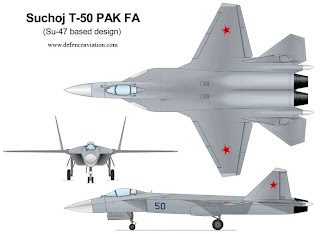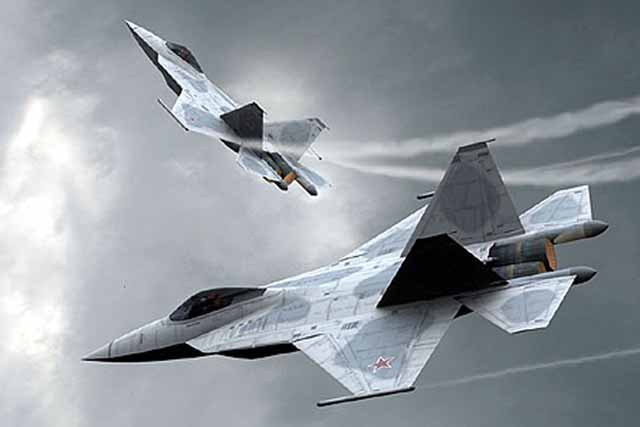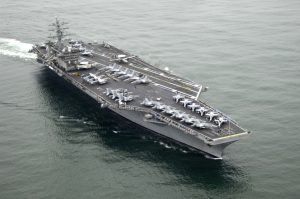The Fifth Generation Fighter Aircraft (FGFA) being jointly developed by India and Russia will look substantially different for the two countries. While the Russian version will be a single-pilot fighter, the Indian variant will have a twin-seat configuration based on its operational doctrine which calls for greater radius of combat operations. The program is initiated to develop a fifth generation fighter aircraft to fill a role similar to that of Lockheed Martin’s F-22 Raptor and the F-35 Lightning II, the world’s first fifth-generation fighter jets.
“The Indian FGFA is significantly different from the Russian aircraft because a second pilot means the addition of another dimension, development of wings and control surfaces,” said Ashok Baweja, chairman of the Hindustan Aeronautics Ltd (HAL), which is developing the aircraft along with Russia’s Sukhoi design bureau.
Speaking to media persons at the eighth Indo-Russian Inter-Governmental Commission on Military-Technical Cooperation (IRIGC), Baweja said that both sides had moved closer towards identifying the key areas of participation in the Fifth Generation Fighter Aircraft Programme (FGFA) for which both countries had signed a joint agreement in 2007. India would bring into play its expertise in composites, lightweight high-strength materials that significantly bring down the weight of an aeronautical platform.
The Russian aircraft is thus called because it is a successor to virtually every fourth and 4.5 generation fighter aircraft like the MiG-29 and Su-30 MKI in the inventories of both countries. It has been dubbed the ‘Raptorski’ for its similarity to the US F-22 Raptor that entered squadron service on December 2005
The first prototype of the Sukhoi Design Bureau’s PAK-FA ‘T-50’ fighter aircraft is set to fly in Russia next year. “We are in the process of defining what part of the contract to give to the Indian production agencies,” said Alexey Fedorov, president of the United Aircraft Corporation, the umbrella organization of Russian fixed-wing aircraft manufacturers. Fedorov said that the process of identifying the participation of Indian partners in the FGFA would be completed by the year-end or in the shortest possible time.
According to Baweja, it features stealth, or a drastic reduction in the aircraft’s radar cross-section or ‘signature’, and the ability to ‘super cruise’ or jet engines that fly stealthily without engaging noisy afterburners even at supersonic speeds, embedded weapons with the capability to engage multiple ground, sea and air targets and seamless communication between the fighter, other aircraft and ground stations. Baweja said that the first prototype of the FGFA was to fly next year with the AL-37FU engine. He said he would want an engine that had 15 to 20 per cent more growth than this engine in the final aircraft configuration. The FGFA is to enter squadron service by 2015 and will replace at least three classes of aircraft in the IAF
The joint-venture borrows heavily from the success of the Brahmos project but seems fated to repeat its story. By the 1990s, Russia, the world’s only operator of supersonic surface-to-surface missiles, had already perfected the Yakhont missile but lacked the funds to pursue its development. Indian stepped in with the finance in 1998 and the missile was re-launched as the Brahmos.
Designs for the PAK-FA have already been frozen by the Sukhoi design bureau, which means that Indian aircraft engineers have already missed out on the critical knowledge curve of aircraft design. Also, the unequal status of the Indian and Russian aviation industries means India will be the junior partner contributing very little except finance. “So if we have missed out on the design phase, we have to analyze the cost-benefits of acquiring only super cruise and stealth technology for $ 10 billion,” asks Air Vice Marshal Kak.
 Decks were cleared for India to jointly develop and produce the fifth generation fighter aircraft with Russia, with New Delhi making the “final choice” on the matter and Moscow saying the work on signing contracts on the deal could begin soon. Observing that Russia had started developing the warplane about three years ago, visiting Deputy Premier and Defence Minister Sergei B Ivanov said “some time back, India showed interest in joining this project. It took them (India) some time to scrutinize the various options. “Now, India has informed us that a final choice has been made. We can (now) open up contractual work for Indian accession to the project,” Ivanov told reporters at a joint press conference with his Indian counterpart A K Antony, after signing four documents. Although interaction has begun on the joint development and production of fifth generation fighter jet, the actual signing of agreements could take some more time.The two sides inked an inter-governmental agreement and a general contract for licensed production of the AL-37FU engines.The fifth generation fighter is based on the Sukhoi fighter and is expected to take its maiden flight in 2012 and inducted by 2015.
Decks were cleared for India to jointly develop and produce the fifth generation fighter aircraft with Russia, with New Delhi making the “final choice” on the matter and Moscow saying the work on signing contracts on the deal could begin soon. Observing that Russia had started developing the warplane about three years ago, visiting Deputy Premier and Defence Minister Sergei B Ivanov said “some time back, India showed interest in joining this project. It took them (India) some time to scrutinize the various options. “Now, India has informed us that a final choice has been made. We can (now) open up contractual work for Indian accession to the project,” Ivanov told reporters at a joint press conference with his Indian counterpart A K Antony, after signing four documents. Although interaction has begun on the joint development and production of fifth generation fighter jet, the actual signing of agreements could take some more time.The two sides inked an inter-governmental agreement and a general contract for licensed production of the AL-37FU engines.The fifth generation fighter is based on the Sukhoi fighter and is expected to take its maiden flight in 2012 and inducted by 2015.



